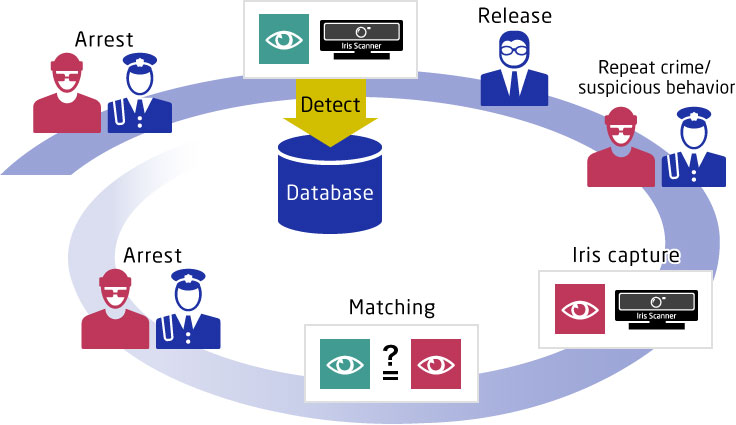Hong Kong
Breadcrumb navigation
Iris Recognition
* For public safety market

- September 22, 2021
The iris is the colored, donut-shaped portion of the eye behind the cornea and surrounds the pupil. A person’s iris pattern is unique and remains unchanged throughout life. Also, covered by the cornea, the iris is well protected from damage, making it a suitable body part for biometric authentication.

Features of iris recognition
- Highly accurate and fast, iris recognition boasts of having top-class precision among different types of biometric authentication technologies.
- Remains unchanged throughout life. (This does not constitute a guarantee.)
- Since the iris is different between the left and right eye, recognition can be performed separately by each eye.
- Possible to distinguish twins.
- As long as the eyes are exposed, iris recognition can be used even when the subject is wearing a hat, mask, eyeglasses or gloves.
- Because of using an infrared camera, recognition is available even at night or in the dark.
- Without the need to touch the device, contactless authentication is possible, making it hygienic to use.


Mechanism of iris recognition
- First, the location of the pupil is detected, followed by detection of the iris and the eyelids.
- Unnecessary parts (noise), such as eyelids and eyelashes, are excluded to clip out only the iris part, which is then divided into blocks and converted into feature values to quantify the image.
- Matching is then performed with feature data previously extracted in the same methods.

Enhancing security through continued R&D
and use of multimodal technologies
NEC R&D
- NEC has patented the entire process from the detection of the iris from photographed images, extraction of the feature values, matching of features, to noise removal.
- NEC is continually carrying out R&D on iris recognition by leveraging its knowhow in fingerprint identification, face recognition, and other biometric authentication technologies that have been recognized as the world’s most accurate.
- NEC offers the most suitable solution fine-tuned to the customer’s environment.
Multimodal Biometrics
- NEC offers solutions that combine fingerprint identification, face recognition, and other proprietary biometric authentication technologies.
Global expansion of iris recognition solution
NEC aims to realize a safe, secure, efficient, and equal society by expanding iris recognition solutions for criminal investigation, immigration control, and national identification systems in different regions around the world.
Immigration Control
In response to the increasing threats of terrorism around the world, NEC contributes to a safe and secure society by enhancing stringency of immigration control. Our iris recognition solution offers improved security and smooth personal identification amidst the increasing movement of people between countries.
- The iris is photographed, and the image is matched with the government’s immigration control database during exit or entry procedures at the passport control booth, enabling rapid and stringent personal authentication.
- Our solution provides improved security through stringent recognition, as well as improved convenience through smooth authentication procedures.

National ID
NEC promotes equal access to administrative services by providing legal identification for all citizens. By enhancing security of national ID systems, our solution contributes to realizing more advanced national identification services.
- Iris recognition is used as one of the methods for acquiring biometric data needed for issuing unique IDs.
- Accurate and fast authentication is possible even without an ID card.
- Combined use with mutually complementary biometric data, such as fingerprint and face, enables rigid personal authentication and a robust approach against impersonation.
- In addition to National ID, the solution is suitable for passports, driver’s licenses, and voter ID systems.

Crime Investigation
A multimodal biometrics database for managing multiple biometric authentication data is created by taking images of the face, fingerprint, and palm print, as well as the iris.
- Combining with fingerprint and other biometric authentication systems enables more accurate identification of an individual.
- Combined use of biometric data allows recognition even when the fingerprint, for example, could not be used for identification due to injury.

